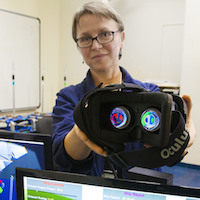|
home
teaching
research interests
current projects
portfolio
students
thesis topics
work opportunities
publications
resources
private
|
|
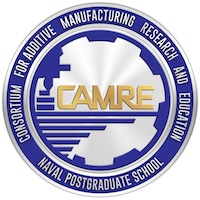 | |
Consortium for Additive Manufacturing Research and Education (CAMRE)
- description: Consortium for additive manufacturing research and education to accelerate widespread adoption of additive manufacturing across the Department of Defense. The Consortium will drive the adoption of 3D rapid prototyping method in support of the Tri-Service Maritime Strategy.
- keywords: additive manufacturing
- sponsor: US Congress
- my role: Co-director
- project duration: Oct 2022 - Sep 2024
|
|
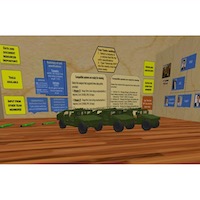 | |
Virtual Environments as Tools for Asynchronous Collaboration of Diverse Communities of Practice
- student thesis by: MAJ Domonique Hittner (US Army), MOVES Ph.D. thesis student
- description: This dissertation introduces a novel theoretical framework that incorporates principles and guidelines for using virtual environments (VEs) as a channel for asynchronous collaboration. The larger context for this research is the potential of VEs to serve as a digital prototyping and collaboration space. The premise of this research is that VEs are capable of supporting diverse communities of practice engaged in the same problem space with heterogeneous objectives and needs. While individuals may need to collaborate in the same physical environment and at the same time, their collaboration may also need to occur asynchronously. The asynchronous form of collaboration may benefit from a new array of VE collaborative tools that goes beyond the capabilities of audio and messaging tools. This dissertations' research goal is to determine the instances where non-immersive (interactive) VEs may support various daily collaborative tasks among heterogeneous communities of practice.
- keywords: virtual reality, asynchronous collaboration, acquisition
- my role: Dissertation advisor and dissertation committee chair (Oct 2020 - Jun 2023)
- thesis document:
|
|
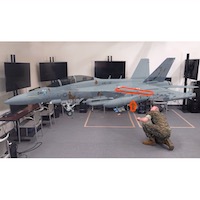 | |
Maintainers on the Grid - Persistent Augmented And Virtual Environments in Support of Aircraft Maintenance
- student thesis by: Capt Michael Ashmore (US Marine Corps),
- description: Aircraft systems are complex, and aircraft operations in tune with maintenance requirements and limitations require coordination with multiple stakeholders for success. Digitizing aircraft maintenance documentation and implantation of technology within maintenance management tools has increased productivity; however, the complexity of these systems and the availability of fewer and more expensive assets with similar high operational demand signals drive the need for further improvements in aircraft maintenance efficiency. Like the jump from physical visual display boards on the walls of maintenance control and paper publications to networked computer bases management tools, the introduction of a persistent augmented and virtual environment (PAVE) to aid the overall maintenance operation presents the next major milestone. This work will propose a novel framework for aircraft maintenance and aviation logistics that utilizes a PAVE approach. We will propose and discuss the elements of that framework and then design and develop an example tool that will utilize the underlying persistent augmented environment; we will examine the usability of the tool in the context of aircraft corrosion control. The goal is to demonstrate how a combination of technologies can support multiple stakeholders across aviation logistics while demonstrating the feasibility of that system’s adoption in the not-too-distant future.
- keywords:
- my role: Thesis advisor (Sep 2022 - Jun 2022)
- thesis document:
|
|
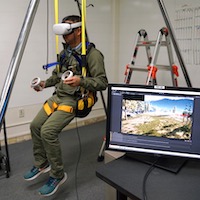 | |
Proof-of-concept Virtual Reality Parachute Training Simulator
- student thesis by: Captain Jose Alfredo Vazquez Duran (Mexican Army), MOVES masters' thesis student
- description: The miscalculation of the height during the landing phase of the parachute jump is found to be a frequent cause of physical injuries among parachute jumpers and paratroopers. Providing trainees with the opportunity to practice parachute jumps in different terrains and acquire good skills when estimating the height (altitude) is essential in reducing, if not even eliminating, future injuries. This thesis research uses virtual reality technology to create a complementary training solution for military parachute training. The proof-of-concept training system uses immersive commercial off-the-shelf (COTS) virtual reality headset and passive haptics technology. This system aims to be used as a part-task trainer; the targeted elements of human performance consist of improvements in situational awareness and human perceptual skills when evaluating heights during parachute jumping. The results of the user study suggest that, much like with the evaluation of horizontal distances, people make systematic errors when evaluating vertical distances. A real-time, interactive virtual environment and training scenarios presented to the trainees inside the virtual reality headset have the potential to help improve trainees’ situational awareness and allow them to practice evaluating the heights more precisely during the landing phase. As a result, this approach may reduce the likelihood of accidents, increase training, and positively affect the level of units' operational readiness.
- keywords:
- my role: Thesis advisor (Jan 2022 - Jun 2023)
- thesis document:
- student award: CDR George L. Phillips Award
|
|
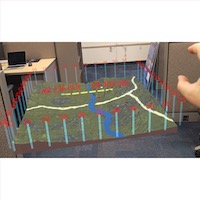 | |
Supporting Combined Arms Military Decision-Making Process with AR Technology
- student thesis by: LTC Carl Caroffino (US Army), MOVES masters' thesis student
- description: he military decision-making process (MDMP) involves the critical task of analyzing the terrain to ensure mission success. However, traditional terrain analysis methods, such as two-dimensional (2D) analog maps, PowerPoint presentations, and mission command systems, are resource-intensive, time-consuming, and can confuse decision-makers. Therefore, this research focused on the use of the mobile, head-mounted augmented reality (AR) display technology for three-dimensional (3D) terrain visualization to address these challenges. AR technology lets users observe virtual objects superimposed onto their physical surroundings, yielding an enhanced immersive experience. The tool allows users to view and manipulate the terrain in 3D, add representations of military resources, examine the resulting configuration, and engage in MDMP. The usability study assessed the effectiveness, efficiency, and user satisfaction with the interface, focusing on 3D visualization tasks, extraction of derivative terrain information, and unit placements in a contested wet gap crossing scenario. The results showed that the AR terrain visualization prototype provided decision-makers with more comprehensive and accurate information, leading to successful mission planning and execution. This research highlights the potential of 3D terrain visualization and AR technology to improve the MDMP, provide decision-makers with a better understanding of the environment, and enable them to make more informed decisions.
- keywords:
- my role: Thesis advisor (Jul 2022 - Jun 2023)
- thesis document:
|
|
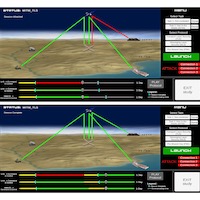 | |
Visual Modeling and Simulation of Cryptographic Protocols Under Contested Environments
- student thesis by: LCDR Floyd Lewis (USN), Cyber Systems and Operations masters' thesis student
- description: With an ever-evolving battlefield in cyberspace, it is essential to stay abreast of current and developing security protocols that will maintain a state of authenticity, confidentiality, and integrity between communicating entities in information-contested environments. The Department of Defense is interested in transitioning its mission objective goals to establishing and maintaining a reliable security posture between communicating command-and-control platforms. However, the current security protocol visualizations need to cater more to military users and decision-makers to help decide which security protocols would best accommodate various operational environments. This research designed and developed a two-dimensional protocol visualization tool (ProVis) that simulates various security protocol interactions in non-contested and contested operational study environments that assist with understanding how security protocols work in the context of military-related usage. A user study was conducted to examine users’ understanding, accuracy, and overall benefit of ProVis concerning the visualization of the Transport Layer Security, Message Layer Security, and Pre-Shared Key protocols. The findings are highly satisfactory: the user subjects were able to easily interface with ProVis and complete the tasks given. The user subjects found ProVis to be a helpful tool in understanding security protocols quickly. This research provides an alternative to current visualization tools.
- keywords:
- my role: Thesis Co-advisor (Mar 2022 - Dec 2022)
- thesis document: https://calhoun.nps.edu/handle/10945/71497
|
|
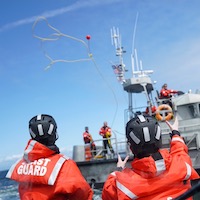 | |
Mapping Virtual and Augmented Reality Training Systems to Support the United States Coast Guard Training Needs
- student thesis by: LT Steven Arnold (US Navy), Systems Engineering masters' thesis student<
- description: This thesis addresses, discusses, and analyzes how to identify and map the use of contemporary virtual and augmented reality (VR/AR) training systems that have been developed by the United States Navy (USN) and how they may be incorporated to resolve United States Coast Guard (USCG) training needs. Through interviews, site visits, and research, data on different training methods was compiled and used to develop a system map. Using this system map and System Engineering principles, this research is able to analyze known VR/AR systems to determine which best fits the requirements of a new system. With the ability to look across military branches to address training needs, the time and money invested in research and development of new training programs could be significantly reduced. A case study is included to provide both a basic outline and explanation on how this system mapping and the follow-on analysis can be used. This research also discusses the advantages and disadvantages associated with using different training methods and how that should affect decision making when choosing a training system.
- keywords:
- my role: Thesis Co-advisor (Dec 2021 - Dec 2022)
- thesis document: https://calhoun.nps.edu/handle/10945/71427
|
|
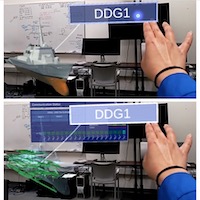 | |
Supporting Mission Planning with a Persistent Augmented Environment
- student thesis by: LT Joanna Cruz (US Navy) and LT JaMerra Turner (US Navy)
- description: The Department of the Navy relies on current naval practices such as briefs, chat, and voice reports to provide an overall operational assessment of the fleet. That includes the cyber domain, or battlespace, depicting a single snapshot of a ship's network equipment and service statuses. However, the information can be outdated and inaccurate, creating confusion among decision-makers in understanding the service and availability of equipment in the cyber domain. We examine the ability of a persistent augmented environment (PAE) and 3D visualization to support communications and cyber network operations, reporting, and resource management decision-making. We designed and developed a PAE prototype and tested the usability of its interface. Our study examined users' comprehension of 3D visualization of the naval cyber battlespace onboard multiple ships and evaluated the PAE's ability to assist in effective mission planning at the tactical level. The results are highly encouraging: the participants were able to complete their tasks successfully. They found the interface easy to understand and operate, and the prototype was characterized as a valuable alternative to their current practices. Our research provides close insights into the feasibility and effectiveness of the novel form of data representation and its capability to support faster and improved situational awareness and decision-making in a complex operational technology (OT) environment between diverse communities.
- keywords:
- my role: Thesis advisor (Jul 2021 - Jun 2022 / Sep 2022)
- thesis document: https://calhoun.nps.edu/handle/10945/71095
- student award: NPS Outstanding Thesis Award
|
|
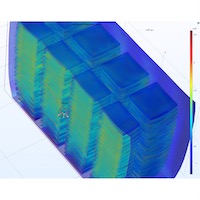 | |
Modeling and Simulations for Optimization of Microfluidic Microcapacitor Arrays of Biomimetic Artificial Muscles for Quiet Propulsion and Exoskeletal Locomotion
- student thesis by: Capt Joshua Keeven (US Marine Corps) and Capt Jacob Leckie (US Marine Corps), MOVES masters' students
- description: The technology that we focused on was the biomimetic actuation of microfluidic microcapacitors, which are electrostatically actuated structures that contract and function like biological muscles. Our thesis aims to find the optimal muscle-to-tendon ratio while expanding both the standard and gap design arrays and to find the respective force-density saturation values so predicted force output can be calculated for muscle fibers of a practical size. We also studied if a 3D virtual object can be a suitable model for the human operators' examination of the artificial muscle and the optimization of its structure. Our results showed a maximum force density saturation of 8800 Pa and 6700 Pa when simulating the standard and gap array respectively with planar polarity wired artificial muscles. The optimal muscle-to-tendon ratio from the data gathered on the standard array simulations is approximately 9 to 1, meaning 90 percent of the surface area of the XY plane represents microfluidic capacitors and 10 percent is dielectric tendon material. The optimal muscle to tendon ratio from the data gathered on the gap array simulations is approximately 75 to 25, meaning 75 percent of the surface area of the XY plane are microfluidic capacitors, and 25 percent is both the dielectric material and gaps.
- keywords:
- my role: Thesis advisor (Jan 2021 - Jun 2022)
- thesis document: https://calhoun.nps.edu/handle/10945/70703
- student award: NPS Outstanding Thesis Award
- publication: Coltelli, M. A., Keeven, J. M., Leckie, J. M., Catterlin, J. K., Sadagic, A., & Kartalov, E. P. (2023). Output Force Density Saturation in COMSOL Simulations of Biomimetic Artificial Muscles. Applied Sciences, 13(16), 9286. link to publication
|
|
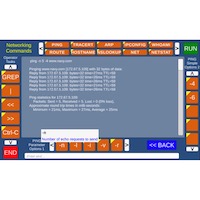 | |
Developing an Expandable Graphical User Interface for Shell Entry (GUISE) Tool for Networking Education
- student thesis by: Clinton Anderson, CS masters' student
- description: The lack of systemic education dedicated to computer networks and the general inadequacy of students' comprehension of the structure and the dynamics of the networks are arguably issues in most public schools. In the situation where the internet is a commodity, the increase in the threat of global attacks on many computing resources is exceptionally high, and so is the consequential importance of the global cyber workforce. Most people achieve their basic understanding through their routine use of computers at home, and it is both pragmatic and more effective to consider using basic home tools because of their didactic benefits. We designed and developed GUISE (GUI for Shell Entry) as an intuitive interface that makes command entry and network analysis easier for masses of users. GUISE leverages the operating system's capabilities and allows inexperienced users with no expertise in the computer networking domain to acquire enhanced network situational awareness in a competent manner. The ultimate benefit of the GUISE tool is providing its users with an educational aspect focused on the networking elements of their home computer infrastructure. That approach has the potential to directly support the growth of their networking literacy and proficiency, and their navigation of the networking landscape with enhanced confidence and safety.
- keywords: network analysis, visualization, user interface
- my role: Thesis advisor (Feb 2021 - Mar 2022)
- thesis document: https://calhoun.nps.edu/handle/10945/69609
- student award: NPS Outstanding Thesis Award
|
|
 | |
Mobile Learning Technology: Assessment of Distribution Options and Recommendations
- description: The transformative Ready Relevant Learning (RRL) effort is transitioning the Navy to a modern, science-of-learning approach. That includes delivering novel training practices and content to the point of need, requiring a true 'anytime, anywhere' capability (wireless access) for locations around the world and in CONUS learning centers and schoolhouses. To deliver modern training capability anytime and anywhere, the Navy must be able to support mobile and distributed training. This requires that Sailors have access to both hardware and software that allow them to access training resources outside the classrooms, at the point of need whenever they require it. The study will examine ways to provide Sailors ready access to mobile learning technologies for the delivery of modern training content anytime and anywhere. We will conduct a Business Case Analysis for procuring government-issued devices versus relaxation of policies and determine the cybersecurity safeguards that would allow personal device use. The goal of the study is to identify the best value solution in a form of an effective technology ecosystem with respect to the categories of hardware (laptop, tablet, mobile phone, etc.) and present a roadmap describing how to implement and adopt the best value solution.
- keywords: mobile learning, technology, training, cybersecurity, technology adoption
- sponsor: OPNAV
- topic sponsor: Naval Education and Training Command (NETC) N51
- my role: co-PI with Dr. Kathryn Aten and Dr. Simona Tick
- project duration: Dec 2021 - Dec 2022
|
|
 | |
Evaluating the Effectiveness of Blended Learning Strategies in Navy Training
- description: The Navy needs better ways to train, educate, and assess higher-order cognitive skills, applied proficiencies, and teamwork abilities. Currently, the Navy's approaches to Instructional System Design (ISD) do not adequately address the development of personalization and adaptive training techniques integrated into the future learning continuum concept required by Ready Relevant Learning (RRL). Adopting a blended training environment approach, which combines a plethora of learning approaches empowered by the modern technology solutions, web-based delivery, and traditional classroom methods, could offer a balanced solution to developing modernized, efficient, effective, and adaptable training delivery systems with integrated ability to assess training quality and impact on Fleet readiness and on-the-job performance.
This study will evaluate the effectiveness of blended training environments against traditional training methods currently used in Navy rating training. The evaluation will use the existing classroom-based curriculum and learning materials in carefully designed reconfigurations that mix web-based interactive content and in-class activities, coupled with an online student evaluation system. Based on the findings, we will present a roadmap on how to implement, adopt and integrate the most efficient training solution that supports the CNO directed acceleration of RRL and provides lessons learned across all Navy formal accession training.
- keywords: blended learning strategies, Navy training, NETC, Instructional System Design (ISD), Ready Relevant Learning (RRL)
- sponsor: OPNAV
- topic sponsor: Naval Education and Training Command (NETC) N51
- my role: co-PI with Dr. Simona Tick, Dr. Kathryn Aten and Dr. Robert Semmens
- project duration: Dec 2021 - Dec 2022
|
|
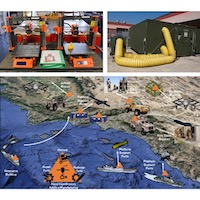 | |
Navy Expeditionary Additive Manufacturing (AM) Capability Integration
- description: The Navy and Marines have been deploying AM capabilities across the Fleet for several years through a variety of efforts. NECF wishes to understand how to maximize return on investment when deploying AM equipment in DMO/LOCE/EABO and other situations while ensuring interoperability with existing efforts by the Navy and Marine Corps and minimizing duplicated efforts. This research aims to aid decision makers in understanding how to best integrate future NECF AM efforts with existing and near-term Naval efforts.
- keywords: additive manufacturing, USMC, Navy, interoperability, acquisition, logistics
- sponsor: OPNAV
- topic sponsor: Naval Expeditionary Combat Command
- my role: Co-PI with Dr. Douglas Van Bossuyt (PI), Department of Systems Engineering
- project duration: Oct 2021 - Oct 2022
|
|
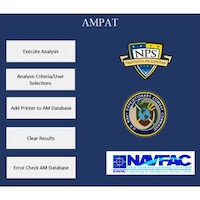 | |
Navy Expeditionary Additive Manufacturing Capability Integration
- student capstone report: Leslie Amodeo, Brian Dick, Charles Flynn, Rebecca Nagurney, Meagan Parker - SE DL master's students
- research domain: additive manufacturing
- abstract: This capstone report analyzes the current and future use of additive manufacturing (AM) technologies within the Department of Defense (DOD). This analysis provided the technical background necessary to develop the Additive Manufacturing Process and Analysis Tool (AMPAT). AMPAT will help stakeholders identify what AM equipment best serves the warfighter and their missions in expeditionary environments. Further, the tool can be used by stakeholders to identify the most advantageous dispersions of AM capabilities across the fleet and make decisions on how those capabilities should be integrated into the greater naval mission and larger DOD enterprise. A systems engineering (SE) approach was implemented to gather information on current and prospective AM methods in order to understand and define the AM system operational requirements. Additionally, an SE process was utilized to analyze alternative software options to build the tool, implement agile software development processes to develop the tool, and verify and validate that the tool met the project requirements. The study found that AMPAT successfully outputs a ranked list of AM systems recommendations based upon user-defined input parameters and weighting values. Recommendations for choosing AM equipment and developing dispersion plans for the fleet include using the AMPAT deliverable to conduct customized, iterative analysis with user-defined inputs that are tailored to specific expeditionary environments.
- keywords: additive manufacturing, expeditionary warfare, systems engineering, 3D printers, Navy Expeditionary Combat Command
- my role: Capstone co-advisor with Dr. Douglas Van Bossuyt, Department of Systems Engineering (Oct 2020 - Jun 2021)
- capstone document: https://calhoun.nps.edu/handle/10945/67651
|
|
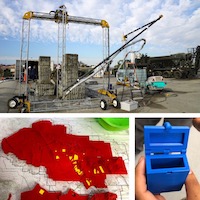 | |
Maker Space Collaboration: Sharing Best Practices and Lessons Learned for Facilities, Equipment and Personnel
- description: More organizations are opening innovation labs solely dedicated to creating new approaches and new solutions to challenges by empowering their members. USMC innovation cells along with additive manufacturing (AM) will have a significant impact on future Navy and Marine operations, and these spaces can be important catalysts for learning, collaborating, and experimenting with rapid prototyping and AM. These spaces can also accelerate the adoption of new technologies within the USMC. As one example of an innovation space, the RoboDojo at NPS is designed to promote informal hands-on learning with open hours and volunteer mentors to help the NPS community learn about rapid prototyping (e.g., with 3D printers and laser cutters) along with numerous other design capabilities for hardware/software integration. Setting up facilities such as the RoboDojo requires diverse equipment and talents and can admittedly be challenging. Repeated site visits and surveys by NPS faculty have shown that innovation-related capabilities are widely encouraged, sometimes supported, but is rarely achieved in the long term. As part of this project, investigators and participants in the RoboDojo and the NPS Center for Additive Manufacturing will interact and collaborate with Marine Corps innovations teams. During and after these visits, we will consider USMC innovation lab requirements and will design and produce an array of support materials which might include educational models, facility guidelines, manuals, teaching/learning materials, and training videos to help share best practices for the benefit of innovators across the Marine Corps.
- keywords: innovation, rapid prototyping, additive manufacturing, technology adoption
- sponsor: OPNAV
- topic sponsor: USMC Systems Command
- my role: Co-PI with Dr. Emre Gunduz and Kristen Tsolis
- project duration: Feb 2020 - Aug 2020
|
|
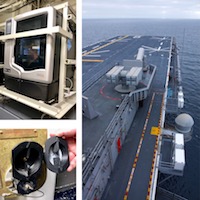 | |
Navy Additive Manufacturing (AM) Afloat Capability Laydown
- description: Several years ago, DON began installing AM capabilities aboard Surface Vessels, and an increased AM deployment to the fleet is planned over the next years. This research aims to aid decision makers in understanding how to best deploy AM resources to the Surface Fleet. The objectives of this research are: (1) Determine what AM equipment may be best to serve the needs of the Surface Fleet; (2) Identify the order in which Surface units should receive AM capabilities; (3) Identify an advantageous dispersion plan of AM capabilities across the Surface Fleet to maximize the benefits. To accomplish the objectives, we will identify existing DON AM equipment, and forecast potential near-term future AM acquisitions. AM systems will be analyzed for capabilities including but not limited to: material options, build volume, operating environment requirements, printed part certification and quality. We will work together with Naval institutions to identify classes of potential parts that can be manufactured using particular AM technology; parts will be analyzed for material requirements, size/volume, quality/certification, rate of use, etc. We will also identify logistics and support requirements for AM equipment; examples may include feedstock type and feedstock shelf life, spare parts, supportability, maintainability, etc. Project work will include conducting the simulations of groups of Surface Vessels to identify how AM equipment can be most effectively deployed to the Fleet. We will conduct sensitivity analyses to attempt to understand what areas may need further data refinement to make informed AM deployment decisions.
- keywords: additive manufacturing (AM), surface fleet, systems engineering
- sponsor: OPNAV
- topic sponsor: N4
- my role: co-PI with Dr. Douglas Van Bossuyt (PI), Department of Systems Engineering
- project duration: Oct 2019 - Oct 2020)
- thesis students: Nathan Banks, Daniel J. Ferreira, Jerome A. Mccauley, Joseph T. Trinh, and Kenneth S. Zust
- thesis: Naval Additive Manufacturing Afloat Capability Analysis
|
|
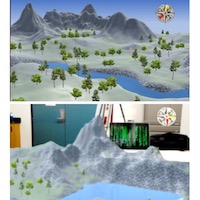 | |
Military Aviation Mission Planning Using Augmented and Virtual Reality
- student thesis by: Maj Bert Knobeloch, German Army, MOVES master student
- research domain: This thesis will focus on a military aviation mission planning tool that harnesses the power and potential of augmented reality technology. A feasibility study at the center of this research effort will seek to design and develop a 3D Mission Planning Environment (3D MPE) with visualization achieved using Augmented Reality technology. The tool will include a variety of interaction modalities to ensure that a good user experience is enabled; this will enable an alternative to conventional mission planning processes (MPP). The main purpose of this system is to augment the current MPE. The system will enable better understanding of the situation and planned mission, provide opportunities for easier recognition of the conditions that lead to incorrect decisions and misjudgments, and enable user interactions and queries that are not possible with traditional MPE tools.
- my role: Thesis advisor (Jul 2019 - Jun 2020)
- thesis document: https://calhoun.nps.edu/handle/10945/65384
|
|
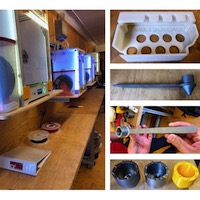 | |
Efficiency for Lethality: Additive Manufacturing ROI Modeling and Complete Adoption
- student thesis by: LCDR Joseph Giordano (US Navy), Master of Business Administration
- research domain: While additive manufacturing (AM) is still in the infancy stages within the DoN for complete adoption, the DoN is interested in knowing how to more accurately measure AM adoption. Ongoing fiscal restraints make adoption of AM a challenging decision over higher-priority programs. A determining factor in the process of making that decision will be the knowledge about the potential AM holds—if the investment in AM is capable of realizing significant savings, return on investment (ROI), and efficiency improvements in the AM procurement process versus traditional procurement methods. Ultimately, sustainable readiness around the fleet and ROI are a high priority. First, the research effort defined the DoN leadership support as part of the National Defense Strategy. Second, we utilized various case studies and data resources from around the DoN to observe where the ROI will be maximized and how ROI directly relates to the large-scale adoption of AM. Third, we culminated with the development of a model that used colored bins to guide the decision-maker to employ AM vice traditional procurement methods. Multiple examples of costs and benefits found during the site visits and ways a decision-maker can adjust and use ROI are offered. Finally, we incorporated the recommendations for increased efficiency of procurement and highlighted areas where AM will be best utilized in the future. The research concluded with a sensitivity analysis and proposed areas of future development.
- keywords: additive manufacturing, AM, AM capacity, cost analysis, AM framework, AM model, AM ROI
- my role: Thesis co-advisor (May - Dec 2019)
- thesis document: https://calhoun.nps.edu/handle/10945/64165
|
|
 | |
Metrics and Measurement in Additive Manufacturing Domain: Adoption and Return on Investment
- description: The work on this project is aimed at creating a comprehensive understanding about the metrics needed to (a) measure adoption of technologies associated with AM, and (b) metrics that would help articulate value added and return on investments made towards adoption and expansion of AM in Naval domain. Project activities includes extensive data collection that incorporates both quantitative and qualitative information collected from stakeholders and adopters (e.g. N4, Naval institutions, Fabrication Laboratories - FABLABs, units). The effort will also include the work on identifying the elements of AM portal - an infrastructure specifically created to house a variety of AM resources, host information about AM adopters, and provide the data about activities in AM domain. The same portal will enable measuring the adoption process, and allow collection of information about adopter-generated innovations and their projected savings. Project activities incorporate multiple visits to Naval institutions and laboratories with AM practitioners, collaboration and information exchange with stakeholders. All field visits will support comprehensive data collection, cataloging and development of metrics of project interest.
- keywords: additive manufacturing (AM), diffusion of innovation, technology adoption, metrics, measurement, return on investment (ROI)
- sponsor: OPNAV
- topic sponsor: N4
- my role: PI (Oct 2018 - Oct 2019)
|
|
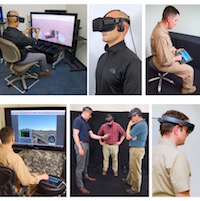 | |
Effectiveness of Training Systems that Employ Virtual Reality, Augmented Reality, and Touchscreen Displays
- description: Recent emergence of low-cost commercial off the shelf virtual reality, augmented reality, touchscreen displays, and a variety of input devices, and a potential they have in addressing the needs of large number of potential users, have raised the hopes and interest of stakeholders in many domains including DoD. Systemic application of those systems in operations and training of preventive and corrective maintenance of mechanical components on Navy ships and installations, would have major impacts on operational readiness. A prominent gap that still exist is concerned with mapping of novel technologies, their sensory modalities and technical capabilities with specific needs exercised by end users. Those user needs are not only reflected in type of skills, desired proficiency levels and retention rates, but also in standards of performances to be reached, forms of delivery and throughput that should be supported. engage in a series of research activities aimed at developing a comprehensive approach that would fill that gap and provide stakeholders with necessary guidance and criteria they can use to select optimal solution for teaching of operations and maintenance courses for Surface Navy Sailors. Our research will include thorough review of literature dedicated to this type of topics, field visits to school houses (A and C schools, operations-based courses), discussions with stakeholders, collection of data that provide comprehensive understanding about user needs, and creation of guidance tool to support selection of optimal training system for specific user needs. Special emphasis will be given to benefits that each system offers, their advantages and disadvantages, and potential issues with large scale adoption. The work will illustrate best use cases, and produce set of recommendations on what future capabilities and systems should be considered to best support the needs of surface Navy sailors.
- keywords: virtual reality (VR), augmented reality (AM), touchscreen displays, haptic devices, military training, human performance, operations, maintenance
- sponsor: OPNAV
- topic sponsor: Center for Surface Combat Systems
- my role: PI (Oct 2018 - Oct 2019)
|
|
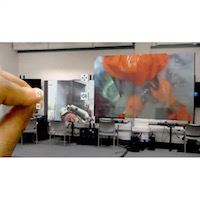 | |
Toward a Persistent Use of Augmented Reality Technology in Naval Domain
- student thesis by: LT Kelvin Huntley (US Navy), IS master student (NWOT curriculum)
- research domain: Augmented reality (AR) technology has been leveraged in a diverse set of tasks in multiple domains of human activity. The persistent use of AR in the naval domain, though futuristic in its application, could provide key decision-makers in a shipboard environment with additional capabilities in their arsenal and support more effective processing of information and sense-making. Though the use of AR has been examined in support of individual tasks, the persistent use of AR and its feasibility in the naval domain has yet to be studied. This thesis explores such feasibility and application on two tasks done by the shipboard commanders, damage control and communications domains, and provides early indicators for the value that the persistent use of AR could bring the U.S. Navy in the future. We designed and developed two applications with corresponding three-dimensional models and user interactions and executed a small-scale user study to acquire early indicators of system usability. While more work is needed in the area of AR in the naval domain, the research conducted for this thesis suggests that AR technology has the potential to improve sense- and decision-making for a variety of personnel onboard naval vessels.
- my role: Thesis advisor (Nov 2018 - Dec 2019)
- thesis document: https://calhoun.nps.edu/handle/10945/64189
|
|
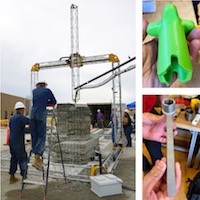 | |
Establishing an Additive Manufacturing NEC for the Machinery Repairman to Enable Efficient Use of AM and Mass Adoption of the Technology
- student thesis by: LCDR Bradford Edenfield, LT Gilbert Garcia, and LT Kazuma Yoshida, GSBPP master degree students
- research domain: Additive Manufacturing (AM) technology has been making significant advances in recent years. While industry has already started exploiting it in its daily operations, the adoption and implementation of AM technology across the Department of Defense (DOD) and Department of the Navy (DON) are still in very early stages. The major value that DOD and DON plan to achieve are improvements in operational readiness, cost-savings, and increases in warfighting capability. The DON has yet to identify the elements of a comprehensive training program across the fleet, including the training of operational level users. Should a Navy Enlisted Classification (NEC) be created for the Machinery Repairman (MR) rating to ensure safe and competent use of AM technology? Does creating an NEC support DOD and DON policies and guidelines of AM Implementation? This report examines those questions and provides a rationale and recommendations for the creation of an AM NEC, including a set of critical skills that should be a part of that training. Methodology developed and used in this report could be applied to examine the needs of other rates beyond MR. Recommended future work emphasizes the need to continue updating the training program recommended in this report, keeping it relevant with advances still being made in AM technology and our growing understanding about DON applications of this technology.
- my role: Thesis co-advisor (Jun 2019)
- thesis document: https://calhoun.nps.edu/handle/10945/62753
|
|
 | |
Enabling Collaboration and Visualization of Complex Operational Technology Computer Networks with Augmented Reality Technology
- student thesis by: LT Matthew Timmerman (US Navy), CS master student
- research domain: Operational Technology (OT) networks are critical to mission operations on many Naval platforms, yet it is often difficult to effectively communicate their status and engage in efficient decision-making at all levels of operation. While the complexity of networks has increased, visualization methods suiting the needs of a diverse set of users have not kept up. To address this problem, this research evaluated if visualization, provided to a small group of operators acting in a shared work environment on network management, can be supported using commercial off-the-shelf, lightweight, portable augmented reality (AR) technology. The work included building a prototype AR OT network on a US Navy Guided Missile Destroyer (DDG) three-dimensional model with four decks, and simulated interconnected ship systems. We then designed and implemented a network infrastructure between a set of Hololenses, and built an application that allowed multiple users to collaborate by viewing the same virtual model in real-world space setting. A study tested the system interface's usability and its value in network management scenarios. The results suggest that a lightweight AR system, with an interface that supports small team collaboration, could be a valuable tool for increasing situational awareness in cyberspace, and allowing effective team decision-making.
- my role: Thesis advisor (Oct 2017 - Dec 2018)
- thesis document: https://calhoun.nps.edu/handle/10945/61287
- conference paper (accepted): Timmerman, M., Sadagic, A., and Irvine, C. (2020). Peering Under the Hull: Enhanced Decision Making via an Augmented Environment. IEEE Conference on Virtual Reality and 3D User Interfaces - IEEE VR 2020, Atlanta, GA, USA.
document and presentation slides: pre-publication copies to be freely available at ResearchGate
conference web site: IEEE VR 2020 http://ieeevr.org/2020/
|
|
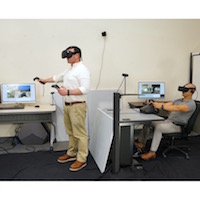 | |
Development of a Virtual Reality Trainer for Tactical Vehicle Ground-guiding
Procedures
- student thesis by: Capt Cody Tackett (US Marine Corps), MOVES master student
- abstract: The use of virtual reality (VR) technology in the training domain brings several benefits to the training force: compared to training in the real world, VR training reduces logistical support, it eliminates high-risk safety situations, and it enables scenarios not possible otherwise. This work determines the viability of using commercial off-the-shelf technology (COTS) to develop a prototype VR trainer in support of tactical vehicle ground-guiding procedures. A task analysis was conducted to identify all steps of the task in which an individual used hand and arm signals to communicate directions and position to another individual who operated a tactical vehicle. This work was used to define elements of human performance and system requirements, and to develop a multiuser VR training system. A total of eighteen subjects participated in a user study to evaluate usability of the system. The prototype system was able to fully immerse the subjects with visual, aural, and haptic displays, successfully blocking out influences from the real world to a sufficient extent that subjects believed they were in the virtual world and could perform ground-guiding operations. Given the subjects' responses in the Standardized Usability Scale questionnaire, the system was seen as a viable tool for training of ground-guiding procedures. The results of this study demonstrated that it is feasible to use COTS technology and create a prototype system for training in ground-guiding and driving skills.
- my role: Thesis advisor (Sep 2017 - Mar 2019)
- thesis document: https://calhoun.nps.edu/handle/10945/62303
|
|
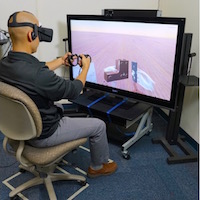 | |
The Role of Stereoscopic Depth Cue and Immersion in Maintenance Task
- student thesis by: Capt Douglas Yamashita de Moura, Brazilian Air Force, MOVES master student
- abstract: Maintenance operations play a critical role in both civilian and military domains, and they can influence the state of their operational readiness. Thus, having access to superior solutions that can be used to train maintenance personnel is essential. Virtual reality (VR) technology, with its capability to simulate 3D objects with high fidelity, is a good candidate for maintenance training solutions. The main component of a large majority of maintenance tasks includes assembly and disassembly of physical setups. These tasks involve judgment of distance, depth, sizing and fit. Various factors may influence the operator's performance in a VR system by affecting perception of the components and, consequently, task execution. Two such factors are stereoscopic depth cue and immersion. This study uses assembly tasks as a context for exploring operator performance while manipulating virtual objects positioned within arm's reach. A user study collected a comprehensive data set over four distinct experimental conditions: immersive stereoscopic, immersive non-stereoscopic, non-immersive stereoscopic, and non-immersive non-stereoscopic. Data analysis suggests that the immersive stereoscopic condition was superior when compared to others; most people in that condition finished their assembly tasks, and they did it in shortest time. No significant simulator sickness issues were recorded in any condition.
- my role: Thesis advisor (Aug 2017 - Sep 2018)
- thesis document: https://calhoun.nps.edu/handle/10945/60363
- conference paper: Yamashita de Moura, D. and Sadagic, A. (2019). The Effects of Stereopsis and Immersion on Bimanual Assembly Tasks in a Virtual Reality System. IEEE Virtual Reality 2019, Osaka, Japan.
document and presentation slides: copies freely available at ResearchGate
conference web site: IEEE VR 2019 http://ieeevr.org/2019/
|
|
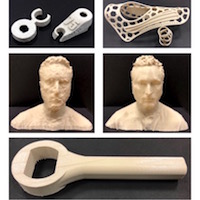 | |
Additive Manufacturing in Naval Domain: Innovation, Adoption and Taxonomy of Cybersecurity Threats
- description: A growing potential and promise that additive manufacturing (AM) brings to Naval domain is matched with a set of activities focused on service members’ innovation, experimentation and rapid prototyping with a range of technologies including AM. Increased level of warfighters readiness and self-sustainment in DON operations are at the center of those efforts. We propose to investigate select elements of innovation and adoption process, and add much needed understanding in domain of cybersecurity. Our research will include activities with Fabrication Laboratories, Maker spaces and units with AM capabilities, and collect a comprehensive data sets relevant to innovation, adoption and cybersecurity. The work will also produce a set of recommendations with guidance directed towards most effective approaches in support of bottom-up innovation process, large scale adoption strategies, and management of cybersecurity infrastructure and needed approaches, all geared towards achieving maximum use of the technology and innovation practices without sacrificing on cybersecurity.
- sponsor: OPNAV
- topic sponsor: N4
- my role: PI (Oct 2017 - Sep 2018)
|
|
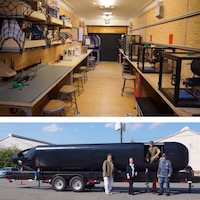 | |
Operational Cyber Security Risks and their Effect on Adoption of Additive
Manufacturing in the Naval Domain
- student thesis by: LCDR Michael Grimshaw, US Navy, CS master student
- abstract: Additive manufacturing (AM) has been proven to provide multiple benefits over traditional manufacturing methods including cost-savings, mission adaptability, and increased unit capabilities. Multiple Department of Defense (DOD) organizations are exploring and utilizing AM technology, and efforts are ongoing to determine how best to achieve large-scale adoption of AM in the U.S. Navy (USN). The primary concern that must be addressed is the trustworthiness of AM objects to ensure they will not increase risks to personnel, equipment, and systems. Including cybersecurity throughout the AM life cycle is a necessary component of protecting AM data and ensuring trust in AM objects to support adoption. This thesis reviews aspects of cybersecurity domain as it is applied to AM, and discusses the insights of a survey conducted with USN, U.S. Army (USA), and U.S. Air Force (USAF) resident NPS students. The goal of the survey was to contrast current understanding of adoption of technology and cybersecurity threats in AM, with the knowledge, attitudes, and opinions that prospective users have. The thesis identifies barriers to achieve large-scale adoption of AM in the Naval domain with special emphasis on cybersecurity, and proposes approaches to address those barriers and support accelerated adoption of AM.
- my role: Thesis advisor (Feb - Dec 2017)
- thesis document: https://calhoun.nps.edu/handle/10945/56931
|
|
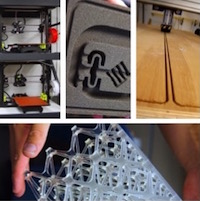 | |
Additive Manufacturing: Technical Issues and Test of Large Scale Adoption in Naval Domain
- description: Project effort includes a design and implementation of a set of comprehensive approaches and strategies in support of diffusion and wider adoption of Additive Manufacturing (AM) in Naval domain. A long-term collaboration will be established with multiple units provided with FAB LAB and mini lab resources, institutions with Modeling and Simulation (M&S) expertise, and military schoolhouses. The effort will study FAB LAB capabilities, select and test a series of 3D tools in support of AM domain, identify and advise on technical elements found to be missing from a desired comprehensive support environment. Our goal is to identify both technical and non-technical barriers to adoption process, generate recommendations on how to resolve them, and get better understanding on timing and adopter groups. This will also include cost; technology maturity; standards set for material, process and software; training approaches and skills required; supporting infrastructure; endorsement and support of leadership; accountability and motivation; peer endorsement; media usage and exposure; user attitudes and domain misconceptions. The effort will propose the strategies and elements of adoption model to support accelerated adoption of AM, and provide advice on further technical advancements for wider adoption of AM in Naval domain. The work will use acquired specifics of AM adoption in Naval domain to further refine our Diffusion of Innovation in Military Domain model.
- sponsor: OPNAV
- topic sponsor: N4
- my role: PI (Oct 2016 - Jan 2018)
|
|
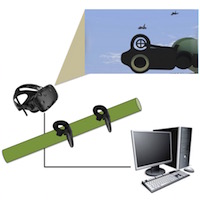 | |
Use of VR technology and Passive Haptics for MANPADS Training System
- student thesis by: Sqn Ldr Faisal Rashid, Pakistan Air Force, MOVES master student
- abstract: Use of VR technology and Passive Haptics for MANPADS Training System
- abstract: Man portable air defense systems (MANPADS) are point-defense weapons that typically form the penultimate layer of defense against aerial threats. Deployed at close ranges to the installation being defended, MANPADS operators get little reaction time to engage attacking aircraft. The situation becomes more complex in a multi-threat scenario such as an airfield under attack. Dealing with such situations requires high proficiency and the capability to make tactical decisions quickly. Live training opportunities allow few operators to fire during live exercises. Simulation training is effective, but customized high-fidelity immersive training facilities are limited. Moreover, low trainee throughput from such high-end facilities is an ongoing obstacle. The main focus of this thesis research is a feasibility study for building a low-cost MANPADS training solution that uses commercial off-the-shelf components. The developed prototype leverages a fully immersive virtual reality system with head-mounted display, game engine, and passive haptics. It provides MANPADS operators with alternative training opportunities in target acquisition, tactical decision making, and situational awareness in a multi-threat scenario, and has the potential of addressing the current training gap. This development experience will provide valuable insights that can be employed to design and create a new generation of low-cost training solutions in other domains as well.
- my role: Thesis advisor (2016 - Sep 2017)
- thesis document: https://calhoun.nps.edu/handle/10945/56170
- awards: Thesis received (1) CDR George L. Phillips Award, and (2) NPS Outstanding
Thesis Award.
|
|
 | |
Searching for Effective Training Solutions in Firefighting Domain: The Analysis of Emergency Responses and Line of Duty Death Reports for Low Frequency, High-risk Events
- student thesis by: Capt Deanna McDevitt, Boston Fire Department, Homeland Security and Defense master student
- abstract:Searching for Effective Training Solutions in Firefighting Domain: The Analysis of Emergency Responses and Line of Duty Death Reports for Low Frequency, High-risk Events
- abstract: Since 9/11, the fire service has experienced a shift and an expansion in the nature of threats and hazards that it faces. Despite advances in the field, firefighters are still losing their lives inside of burning buildings, and they must find new ways of identifying training gaps and improving current training practices. This thesis explores whether emergency incidents connected to low frequency and high risk events contain sufficient warning signs or indicators of imminent catastrophic events, if firefighters could identify them, and if there was a potential of changing decision making and averting a tragedy. In order to create a firm basis for this discovery, this research effort included a detailed analysis of the National Institute for Occupational Safety and Health's line of duty death reports from the years 2013-2015. The work provided an opportunity to learn from past events and practices and identify successes and failures in the firefighting domain without the bias of being closely involved with the cases or having a specific agenda. Quantitative analysis performed on this data set and the knowledge gleaned from looking at the events after the fact provide a foundation for advising novel training approaches and scenarios that can be used to train both individuals and teams of fire fighters.
- my role: Thesis advisor (2016 - Sep 2017)
- thesis document: https://calhoun.nps.edu/handle/10945/56157
|
|
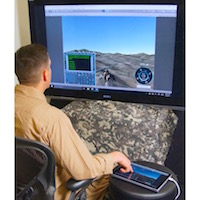 | |
Marine Light Attack Helicopter Close Air Support Trainer for Situational Awareness
- student thesis by: Maj John Gibson, US Marine Corps, MOVES master student
- research domain: In today's dynamic combat environment, the importance of Close Air Support (CAS) has increased significantly due to a greater need to avoid civilian casualties and fratricide while maintaining effective fire support for engaged friendly forces. Situation awareness (SA) is a skill that is extremely important in conducting CAS safely and effectively, and is frequently one of the greatest deficiencies of new pilots. As budgets shrink and throughput on current training solutions remains very low, it is difficult to provide new CAS aviators with the number of training repetitions needed to gain SA proficiency. A tablet computer-based CAS part task trainer (PTT) to improve SA was developed to address this. This system provides the visual and audio stimuli of the CAS battlefield and trains a new pilot to observe the environment, listen to communications, comprehend what is happening, and make timely inputs based on his or her understanding of the overall situation. Throughout the training, the system provides questions to the student to evaluate the student's level of SA and to emphasize key SA elements. The lessons delivered by the prototype CAS PTT suggest that it will be useful to teach CAS situation awareness and improving the performance of new pilots. Continued development of a series of low-cost part task trainers that fill different training gaps could result in significant improvement in training future generations of aviators.
- my role: Thesis advisor (2016 - Jun 2017)
- thesis document:
https://calhoun.nps.edu/handle/10945/55601
- award: Thesis received NPS Outstanding Thesis Award.
|
|
 | |
Proof-of-concept Part-task Trainer to Enhance Situation Awareness for Instrument Approach Procedures in Aviation Domain
- student thesis by: Capt Nicholas Arthur, US Marine Corps, MOVES master student
- research domain: The terminal environment in the aviation domain is referred to as the region within close proximity of airports. Performance in this environment leaves little room for error and requires that pilots are fully aware of their situation and surroundings. This is especially true when conducting an instrument approach (IA). Currently, United States Marine Corps (USMC) KC-130J units do an exceptional job of training their pilots in this environment. However, the emergence of new technologies affords the opportunity to address shortfalls of legacy training approaches. To this end, this thesis uses a quasi-instructional systems design approach to develop a prototype IA part-task trainer (PTT) using commercial off-the shelf (COTS) systems to enhance current training methods to allow for training opportunities that are not limited by schedules or location. After the development of the PTT, subject matter experts evaluated the prototype training system. Their feedback suggests that the system reliably recreated necessary cues (cockpit displays, environmental conditions, communications, time, and space) to build on users’ existing knowledge and support situation awareness training for IA. Ultimately, the proof-of-concept prototype created for this thesis is envisioned to be part of a family of solutions capable of addressing existing training gaps in a cost-effective manner.
- my role: Thesis advisor (2016 - Jun 2017)
- thesis document: https://calhoun.nps.edu/handle/10945/55508
|
|
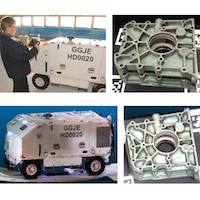 | |
CAD Interoperability for Navy Reuse in 3D Printing, Maintenance and Training
- description: Preventive and corrective maintenance of mechanical components on Navy ships and aircrafts is a complex task that can have major impacts on operational readiness. In situation when a component needs to be delivered to a remote team (an off shore installation or ship), the final cost of transit and delivery can be further exacerbated if newly received component is confirmed not to be adequate, leading to a new iteration of physical delivery. This results in extreme and unplanned costs of the overall mission. We propose to design and test maintenance workflow that utilize the emerging capabilities of novel technologies like 3D scanning, 3D printing and stereoscopic display, ensuring that only fully tested physical components will ever be shipped to remote unit. This process can be seen as a virtualization of corrective procedures, where instead of physical components, local and remote teams exchange a set of virtual artifacts, test mock-up objects and resort to final delivery only when they are sure the new component is a perfect fit. This delayed and in-time manufacturing and transit, fully supporting the concept of smart manufacturing grid, represent the essence of policy that has energy savings at its core. The benefits of this approach will be directly applicable to many other segments of DoD and civilian domains.
- sponsor: OPNAV
- topic sponsor: N4
- my role: PI (May 2015 - Dec 2016)
|
|
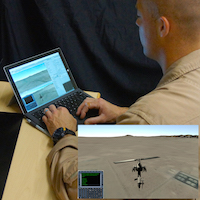 | |
Proof-of-concept Part-task Trainer for Close Air Support Procedures
- student thesis by: Maj Jesse Attig, US Marine Corps, MOVES master student
- abstract: Transitioning between two training phases of the close air support (CAS) syllabus can be difficult for pilots under instruction (PUIs). The level and variety of skills needed for each stage may not be acquired in the previous step, which makes it difficult for the pilot to take the most value from the current stage of training. By providing PUIs with supplemental training solutions that aim to bridge those training gaps, it may be possible to increase the value of the ultimate, but time-limited, training opportunities like simulator and actual flight events. This research prototyped a supplemental training solution that offers a context-relevant, immersive virtual environment that removes the need to fly or operate the aircraft system, thus enabling the trainee to focus only on improving the skills related to problem schema (communication, decision making, and CAS procedures). The resulting system enables repetitive, individual training of CAS communication and procedure skills similar to “chair flying” combined with tactically correct examples of CAS missions used during “chalk talks.” An informal user study indicated this approach has the potential to make the transition to the simulator or aircraft much easier and could offer a viable training solution in an increasingly fiscally constrained environment.
- my role: Thesis advisor (2015 - June 2016)
- thesis document: http://calhoun.nps.edu/handle/10945/49487
- award: Thesis received NPS Outstanding Thesis Award.
- conference paper: Attig, J. and Sadagic, A. (2016). Virtual Part-task Trainer for Close Air Support Leveraging COTS, Interservice/Industry Training, Simulation, and Education Conference (I/ITSEC-2016), Orlando, FL.
document and presentation slides: copies freely available at ResearchGate
conference web site: I/ITSEC web site
|
|
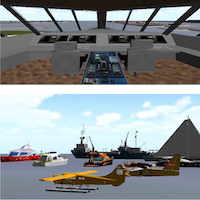 | |
Use of Game Based Approach to Train and Test Rules of The Road: A Feasibility Study
- student thesis by: LT Jay Taylor, US Navy, CS master student
- abstract: This thesis will determine the viability of implementing game based simulation to train and test the Rules of the Road (RoR). The critical information presented in International Regulations for Prevention of Collisions at Sea, 1972 (72 COLREGS) manual is currently learned by rote memorization. We believe that an alternative approach to train and test these rules – a game based simulation - would allow for better comprehension of critical concepts, visualization of different conditions, inclusion of actual auditory references and situational application of the right of way by engaging a user interactively in scenarios that illustrate different elements of the RoR. This project will benefit Navigators, Conning Officers, Helmsmen, the Coast Guard and civilian mariners who need to learn the Rules of the Road.
- my role: Thesis advisor (2014 - 2016)
|
|
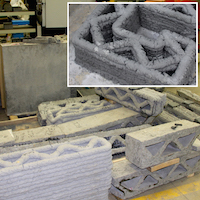 | |
Additive Manufacturing (AM) in Expeditionary Operations: Current Needs, Technical Challenges and Opportunities
- student thesis by: Capt Matthew Friedell (US Marine Corps), MOVES master student
- abstract: Additive manufacturing (AM), or 3D printing, is poised to change the world of military expeditionary operations. It has the potential to affect every element of military operations—logistics, training, simulation, and warfighting. However, these cutting-edge technologies are shifting so rapidly that the current military acquisition system is not prepared for their adoption on a large scale. Among the issues that need to be addressed are 3D watermarking of digital models, proper prints in a distributed system, security of a repository of 3D models, and on-site customization of existing models. The author performed an empirical study centered around a survey of United States Marine Corps (USMC) and United States Navy (USN) personnel. The objective was to determine which of the promising 3D technologies have been adopted in United States Marine Corps and United States Navy and which should (or should not) be adopted. The survey and thesis conclude that AM and Contour Crafting have a lasting place in future USMC and Navy operations. Adoption of AM in the USMC and USN is still rare, but most agree that it can be used to great effect. The thesis recommends that more studies be performed to determine the best way forward for AM within the USMC and USN.
- my role: Thesis advisor (2015 - June 2016)
- thesis document: http://calhoun.nps.edu/handle/10945/49461
|
|
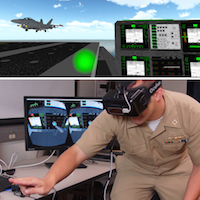 |
|
'Charlie', Development of a Lightweight, Virtual Reality Trainer for the LSO Community
- student thesis by: LT Larry Greunke (US Navy), CS master student
- abstract: Landing Signal Officers (LSOs) are the backbone of tailhook naval aviation. Currently, once a junior officer is selected from a squadron to become a LSO, that person will typically go through an entire workup cycle before going to the Initial Formal Ground Training (IFGT) course. This means that an LSO will undergo months of on-the-job training at sea and assume different roles needed to recover aircraft before that individual receives his/her first formal training during IFGT. At the center of IFGT is the LSO Trainer, Device 2H111, in which the LSO receives a series of six one-hour long sessions. For many LSOs this will be the only interaction will this training simulator.
The aim of this thesis was to develop and evaluate whether major training objectives for the 2H111 could be supported using a proof of concept, light-weight, portable VR trainer with a VR HMD as its display solution. Thesis work included feasibility testing of a Graphical User Interface and voice recognition integration into a simulation to facilitate both an individual and a team training environment. The result of the study is that technology has come far enough to support a commercial off the shelf technology solution.
- my role: Thesis advisor (2014 - Sep 2015)
- thesis document: https://calhoun.nps.edu/handle/10945/47267
- awards: Thesis received (1) NPS Gary Kildall Award for Computing Innovation, (2) NPS Outstanding Thesis Award. LT Greunke received Honorable Mention (3rd place) in category of Innovation Scholar (PME), The SECNAV 2015 Innovation Award given by the Secretary of the Navy, Department of the Navy - Innovation (announcement).
conference web site: IEEE VR 2016
- journal paper: Greunke, L. and Sadagic, A. (2016). Taking Immersive Leap in Training of Landing
Signal Officers. IEEE Transactions on Visualization & Computer Graphics, Vol.22, No. 4, pp. 1482-1491, April 2016.
document: doc
journal web site: IEEE TVCG
conference web site (IEEE Virtual Reality 2016, Greenville, SC, USA): IEEE VR 2016
- research demo: Greunke, L. and Sadagic, A. (2016). Immersive VR Trainer for Landing Signal Officers,
IEEE Virtual Reality 2016 conference, Greenville, SC.
web page: Research Demos
|
|
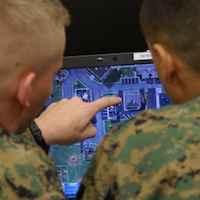
|
|
The Effectiveness of By-Proxy Training Setup in Computer Supported Training Simulations
- description: The recognized training potential and benefits that computer-supported training simulations and game-based systems bring to training regimen of military is still in stark contrast with a lack of large scale adoption of this type of tools in daily practice of military units. One of the major obstacles in this process that has been mentioned to us in interviews we had with people who work in simulations centers and with service members, is the issue of a throughput in simulation centers; some units give up on using the systems simply because the centers are not able to provide a 'hot seat' to each unit member. Our study will design and test the effectiveness of training session that uses an arrangement where one or a small number of trainees are in the 'hot seats' and the rest of training force observes his/their actions and engages in training session in 'by-proxy' manner (this could be smaller or larger group of trainees).The engagement of this ‘observer’ group can go from purely observing the session with no feedback expected from them, to the other end of the spectrum where the group is more actively engaged and requested to perform their individual or team tasks.
- my role: PI (2014 - 2015)
|
|
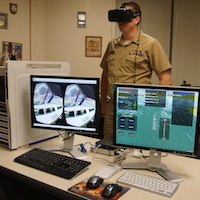 |
|
Navigational Head's Up Display (NAVHUD): Will a Shipboard Augmented Electronic Navigation System Sink or Swim?
- student thesis by: LT Brendan Geoghegan (US Navy), CS master student
- abstract: The aim of this thesis is to develop and test a proof-of-concept augmented reality display that presents critical navigation information to naval conning officers. The objective of this research effort was to study the feasibility and usability of such an approach in operational conditions. The testbed platform consisted of a virtual environment that fully simulated a conning officer’s basic tasks in conditions of restricted navigation; this type of setup enabled a cost effective test solution that was safe and supported scenario repeatability in studies with human subjects. The study involved 25 experienced test subjects who were surface warfare officers at both the Naval Postgraduate School and Surface Warfare Officer School. This effort helped acquire a comprehensive set of objective and subjective data that provided a close insight into the performance of conning officers. The empirical results demonstrate the viability of using such a system in an operation environment and support a need for further research and development of a working display platform onboard Navy warships.
- my role: Thesis advisor (2014 - Mar 2015)
- thesis document: https://calhoun.nps.edu/handle/10945/45191
- awards: Thesis received NPS Outstanding Thesis Award. LT Geoghegan was a Winner in the category of Innovation Scholar (PME), The SECNAV 2015 Innovation Award given by the Secretary of the Navy, Department of the Navy - Innovation (announcement).
|
|
 | |
Development of a Web-based Periscope Simulator for Submarine Officers Training
- student thesis by: LT Ricardo Sampaio Bastos (Brazilian Navy), MOVES master student
- description:This thesis addresses the instructional gap existent between the theoretical instruction that is typically delivered in the classroom and the hands-on training in periscope simulators. In those navies that adopt the "eyes-only" or "perisher" technique for training of periscope depth safety rules, the submarine officers need to gain knowledge and master a series of skills and abilities prior to the training sessions in periscope simulators. This work suggests and explores the use of web-based simulation as a tool to diminish this gap, applying the concept of part-task training to enable the delivery of better-prepared officers to the simulator phase of training and better leverage the time spent at a full-scale simulator. To test this concept, a prototype web-based periscope simulator was developed, and a usability study was conducted among the body of students of the Naval Postgraduate School. The findings revealed that most of the participants were receptive to web-based simulation for training, and that it is a viable and promising field, but some technical caveats were identified. Although this thesis focused on the periscope simulation, the concept can be extended and applied for other domains in which a similar gap can be found between theory and hands-on training.
- my role: Thesis co-advisor (2013 - 2014)
- thesis document: http://calhoun.nps.edu/handle/10945/43873
- awards: Thesis received NPS Outstanding Thesis Award
|
|
 | |
Global ECCO
- web: project web page
- description: Global ECCO's mission is to build and strengthen the Combating Terrorism Fellowship Program's (CTFP) global alumni network of Combating Terrorism (CbT) experts and practitioners through innovative and engaging technologies and techniques that both enable and encourage collaborative partnership between individuals, nations, organizations, and cultures.
- collaborating institutions: Naval Postgraduate School (NPS): Defense Analysis Department, MOVES Institute;
Institute for Creative Technologies (ICT)
- my role: Expert advisory role for HCI solutions (user interface), and elements of multiuser online community
(Concepts and community elements in support of user collaborative activities and self-sustainable nature of online
community). Year: 2014
|
|
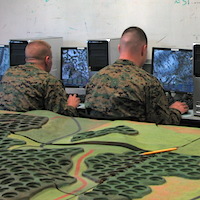 | |
Diffusion and Large-scale Adoption of Computer-supported Training Simulations in the Military Domain
- student thesis by: Maj. Floy Yates (US Marine Corps), MOVES master student
- description: The focal point of this thesis is the overall process of diffusion and adoption of technological innovations (computer-supported training simulations) within the military domain. The goal was to capture the positive and negative trends that appear to be the most significant toward the adoption process. The approach selected in this thesis was to execute a user study and collect a set of data points concerned with the users' overall demographics, attitudes, expectations, knowledge, misconceptions, usage, advertising, leadership endorsement, and other elemental characteristics for adoption of those systems in the military domain. The data survey was conducted within MCAGCC, Twentynine Palms, CA; it addressed specific needs of four different groups of users (Trainees, Unit Leadership, Trainers, and Base Leadership). The analysis of collected data sets demonstrated that diffusion and adoption of these types of solutions is a complex, multilayered problem that goes beyond the characteristics of the systems/tools. The summary of user profiles, attitudes toward technology, and other elements relevant to the training domain demonstrated that clearly. The findings in this work can be generalized to any other USMC base, and have a universal value applicable to the adoption of computer-supported training simulations by other DoD services.
- collaborating institutions: Naval Postgraduate School (NPS) MOVES Institute, and MCAGCC, Twentynine Palms, CA
- my role: Thesis advisor (2013)
- thesis document: http://calhoun.nps.edu/handle/10945/37746
- conference paper: Sadagic, A., and Yates, F. (2015). Large Scale Adoption of Training Simulations: Are We There Yet?. Interservice/Industry Training, Simulation, and Education Conference (I/ITSEC-2015), Orlando, FL.
document and presentation slides: copies freely available at ResearchGate
conference web site: I/ITSEC web site
|
|
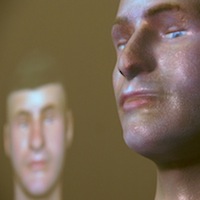 | |
3D Display and Capture of Humans for Live-Virtual Training
- web: project web page
- description: We are carrying out research, development, and evaluation of work in both 3D display and sensing, initially aimed at Mixed/Augmented Reality-based live-virtual training, but with potential for broader impact. The first component of the work is aimed at a new idea for creating physically present virtual humans in 3D, without the need for HMDs or special time/phase/wavelength glasses. Our basic approach is to extend our earlier work in projector-based Shader Lamps to dynamically remap the shape and appearance of virtual or real humans onto human-shaped display surfaces. The second component of the work is aimed at a new idea for hybrid global/body-relative and cooperative estimation of full kinematic body and weapon posture, supporting multiple individuals working in close proximity during training exercises, for both kinetic and non-kinetic scenarios. The third component of the work is aimed at obtaining a thorough understanding of a relevant training domain, its actors, and their specific needs (both current and projected). This involves the investigation and reporting on the basic elements of their acting in related environment in the context of the 3D display and sensing efforts.
MOVES segment: domain analysis of three different training environments/domains (fire drills on ships and submarines, urban warfare operations, tactical cultural awareness training), and a series of user studies in a domain of Shader Lamps-based physical avatars.
- sponsor: Office of Naval Research (ONR)
- funding level: $1.2 M
- collaborating institutions: University of North Carolina at Chapel Hill (UNC) - lead, and Naval Postgraduate School (NPS)
- my role: co-PI on joint project (FY09 - FY12: four years project)
|
|
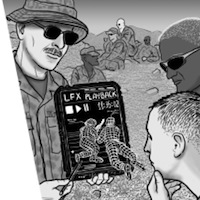 | |
Behavioral Analysis and Synthesis for Intelligent Training - BASE-IT
- web: project web page ,
concept figure
- description: A primary objective is to develop a state-of-the-art intelligent training system for pre/in/post evaluation using behavior analysis, review, and behavior synthesis as well as a set of training approaches, aimed to support a wide range of training and operational needs in preparing for and conducting the training in MOUT facilities.
Our proposed approach is to use an in situ network of automatically-controlled pan, tilt and zoom (PTZ) cameras, and personal position and orientation sensing devices, to create static three-dimensional (3D) environment models, dynamic 3D participant models, and dynamic multi-dimensional participant pose tracks that can be viewed from any perspective. The system will include automatic semantic parsing of the dynamic models and tracks, with interactive and automatic configuration, event detection, and annotation to increase the usefulness and effectiveness of reviewed material. We also plan to devise a novel set of training and instructional approaches specially designed for this set of systems and tools.
- sponsor: Office of Naval Research (ONR)
- funding level: $6.5 M
- collaborating institutions: Naval Postgraduate School (NPS) - lead, Sarnoff Corporation and University of North Carolina at Chapel Hill (UNC)
- partners: TECOM, PM TRASYS, TTECG
- other NPS faculty members and PostDocs involved: Dr. Chris Darken, Dr. Neil Rowe, Dr. Mathias Kolsch, Dr. Juan Wachs, Deborah Goshorn and Delta3D team
- co-PIs and researchers from collaborating institutions: Dr. Henry Fuchs, Dr. Greg Welch, Dr. Marc Pollefeys, Dr. Jan-Michael Frahm, Dr. Anselmo A. Lastra, Herman Towles, Dr. Rakesh "Teddy" Kumar, Dr. Hui Cheng, Dr. Harpreet Sawhney, Dr. Chumki Basu.
- my role: PI for the three institutions team (FY08 - FY11: four years project)
|
|
 | |
Integrating Intelligence and Building Teams Within the Infantry Immersion Trainer
- student thesis by: Maj. Craig R. Schwetje (US Marine Corps), MOVES master student
- description: The trend of focusing on technology in "technology augmented environments" and practicing a set of skills in isolation needs to shift towards user-centered training with skills being integrated earlier in the training process, as long as conditions for that integration exist. The purpose of this thesis was to examine whether incorporating intelligence briefs and debriefs with a Squad Planning Operations Center (SPOC) supported by suitable technologies improved infantry training in urban warfare training situations. To prepare for this task, a pilot study was conducted following current Infantry Immersion Trainer (IIT) procedures for the control group, while the experimental group utilized an Augmented Combat Operations Center (A-COC). Information gained from this study was then utilized for the main study conducted at the IIT aboard Camp Pendleton, CA. This study was conducted utilizing sixty participants in the control group (following current IIT procedures) and ninety-three participants in the experimental group (IIT procedure augmented with the use of a SPOC). The most statistically significant difference between the groups came from the participants' self-assessment on training confidence and overall success of training. Members of the experimental group, after utilizing the SPOC for planning, felt more confident in completing their training tasks and their view of achieving success in executing their mission was also higher.
- my role: Thesis advisor (2008-2009)
- thesis document: http://calhoun.nps.edu/handle/10945/4619
|
|
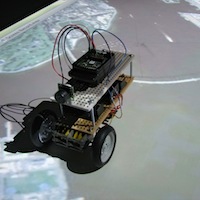 | |
Integration of Robotics and 3D Visualization to Modernize the Expeditionary Warfare Demonstrator (EWD)
- student thesis by: Maj. Christian R. Fitzpatrick (US Marine Corps), MOVES master student
- description: In the summer of 2008, the Commandant of the Marine Corps (CMC) released a message to all Marines and Sailors detailing plans to revitalize U.S. naval amphibious competency. Current responsibilities in Iraq and Afghanistan have significantly reduced available training time causing overall amphibious readiness to suffer. In response, this thesis evaluates 3D visualization techniques and other virtual environment technologies available to support these mission-critical training goals. The focus of this research is to modernize the Expeditionary Warfare Demonstrator (EWD) located aboard Naval Amphibious Base (NAB) Little Creek, Virginia. The EWD has been used to demonstrate doctrine, tactics, and procedures for all phases of amphibious operations to large groups of Navy, Marine Corps, Joint, Coalition and civilian personnel for the last 55 years. However, it no longer reflects current doctrine and is therefore losing credibility and effectiveness. In its current configuration, the EWD is limited to a single training scenario since the display's ship models rely on a static pulley system to show movement and the terrain display ashore is fixed. To address these shortfalls, this thesis first recommends the usage of the wireless communication capability within Sun's Small Programmable Object Technology (SunSPOT) to create robotic vehicles to replace the current ship models. This enables large-group visualization and situational awareness of the numerous coordinated surface maneuvers needed to support Marines as they move from ship to shore. The second recommendation is to improve visualization ashore through the creation of Extensible 3D Graphics (X3D) scenes depicting high-fidelity 3D models and enhanced 3D terrain displays for any location. This thesis shows how to create these scenes and project them from overhead in order to modernize the gymnasium-sized EWD into an amphibious wargaming table suitable for both amphibious staff training and operational planning. Complimentary use of BASE-IT projection tables and digital 3D holography can further provide small group, close-up views of key battlespace locations. It is now possible to upgrade an aging training tool by implementing the technologies recommended in this thesis to support the critical training and tactical needs of the integrated Navy and Marine Corps amphibious fighting force.
- my role: Thesis co-advisor (2008-2009)
- thesis document: http://calhoun.nps.edu/handle/10945/4520
|
|
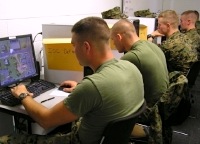 | |
Studying the Synergy of Virtual Training Simulations and Novel Training Methodologies
for Training of the Ground Officers, and Evaluation of Training Effectiveness
- web: /
- description: This research effort engages the faculty and students in tackling two groups of
research issues: firstly it is a design of novel training approaches, instructional strategies and
pedagogies specially created to be used in a conjunction with the virtual training simulations with
the goal to maximize the likelihood of getting positive training results in those systems, and secondly the
scientifically based investigation of the effectiveness of the same methodologies when used with selected
virtual training simulations and with specific user population.
The nature of our research, the form of investigation and the data collected in the study will be
designed in a way that ensures the applicability of the same results to all DoD services (Navy,
Marine Corps, Army) and for a wider family of virtual training simulations.
- sponsor: Navy Modeling and Simulation Office (NMSO)
- partners: TECOM, TBS and IOC (Quantico, VA)
- my role: PI (2007 - 2008)
|
|
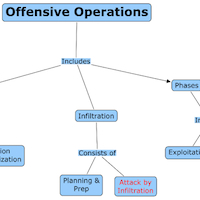 | |
The Use of Concept Maps for the Diffusion of the Distributed Operations Concept and the Dissemination
of Existing Virtual Training Simulations
- student thesis by: LT Brian S. Boone, USN, MOVES master student
- description: The Marine Corps finds itself increasingly fighting an elusive, adaptive and decentralized enemy. Facing this type of decentralized enemy suggests the Marine Corps embrace a more decentralized approach to conventional military operations. One of the strategies that the USMC has been introducing is Distributed Operations (DO) that will enable meeting the need of commanders to fight a highly decentralized engagement. DO require that the Marine Corps add to its conventional skills the additive ability to decentralize decision making and an ability to distribute the force when it is tactically advantageous to do so. Lessons learned from the Hunter Warrior series of experiments suggest that technology can only be effectively applied once assigned tasks have been mastered. In order for the Marine Corps to enable DO capability throughout the Marine Corps, a proactive information campaign must be conducted. The thesis seeks to develop a web based collaboration tool which will link critical DO specific and conventional skills to the current simulations which train them. This will serve to increase all Marines' understanding of the requisite knowledge and introduce novel training opportunities that exist as the concept of DO is concurrently developed.
- my role: Thesis advisor (2007 - 2008)
- thesis document: http://calhoun.nps.edu/handle/10945/4294
|
|
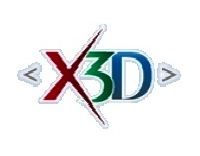 | |
X3D-Earth: Archivable Composed Collaborative Web-Based 3D Visualization with Global
Geospatial Context for Complex Analysis and Evaluation of Intelligence Products
- web: X3D-Earth Workshop (Nov 14-15, 2006, Monterey, CA):
www.web3d.org/news/events/index.php#x3dearth_workshop
- description: The Naval Postgraduate School (NPS) Modeling, Virtual Environments, and
Simulation (MOVES) Institute proposes the X3D-Earth project for creation of a vast
integrated analytical visualization framework not bound to specific devices, data sources,
data formats, or rendering applications, but based on open standards facilitating
interchange and interoperability across diverse systems for collaborating teams of
intelligence analysts.
Studies that I lead: baseline study, user studies (explore novel user metaphors and complex
display solutions in support of specific requirements generated by domain users possible to be
served by X3D solutions), evaluation of the user effectiveness while using X3D solutions.
- sponsor: DTO
- partners: Aniviza, Inc., Intelligraphics, Media Machines, Planet 9, Polished Pixels,
Yumetech, Ping
- my role: co-PI with Dr. Don Brutzman (FY07 - FY09)
|
|
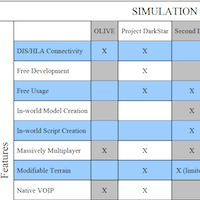 | |
Requirements to Create a Persistent, Open Source, Mirror World for Military Applications
- student thesis by: LT Kent L. Sanders (US Navy), MOVES master student
- description: With many free simulations available to developers, it is desirable to marry the existing library and work of these simulations in an attempt to create a completely open source virtual reality environment to facilitate computer aided training and simulation. Key problems associated with developing a large scale Multiple User Virtual Environment (MUVE) are analyzed including appropriate server - client architecture, terrain and object model formats, and overall project scalability. Solutions to these problems are proposed and analyzed, including using existing commercial and open source projects in development, using projects already deployed, or the feasibility of developing a new solution to meet the requirements of this thesis. Advantages, disadvantages, and possible military and educational uses for each of these free simulations and the associated persistent mirror worlds are also analyzed to recommend a direction of action for military and education simulation and training.
- my role: Thesis co-advisor (2007)
- thesis document: http://calhoun.nps.edu/handle/10945/3137
|
|
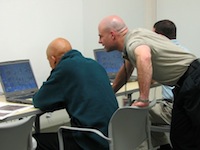 | |
Training Methods and Tactical Decision Making Simulations
- student thesis by: Maj. Charles Neil Fitzpatrick III (US Marine Corps), MOVES master student, and
Capt. Umit Ayvaz (Turkish Army), MOVES master student
- description: Introducing simulation training to ground officers for the first time, within an existing proven curriculum, presents a number of challenges and questions. The proper amount of simulation time to evaluate and train skill sets and how to introduce simulation into an existing curriculum are mostly unknown. We have completed two studies at the Naval PostGraduate School (NPS). The first study examined the length of time and the most appropriate method for introducing simulation training to a user. The second study compared the use of the Close Combat Marines (CCM) Tactical Decision-Making Simulation (TDS) with the traditional method of training decision-making called the Tactical Decision-Making Game (TDG). The TDS and TDG were used in a between-subjects experimental design to examine the viability of each with regard to their ability to evaluate several important military traits. We found that both the TDG and the TDS methods were useful in evaluating a participant's leadership characteristics and decision-making ability. However, only the TDS was capable of evaluating situational-awareness. Our results also address a novel way in which these two approaches could be combined to amplify each other's potential in training of ground officers and military personnel in general.
- my role: Thesis advisor (2006 - 2007)
- thesis document: http://calhoun.nps.edu/handle/10945/3348
|
|
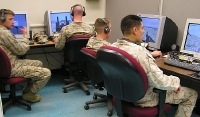 | |
Evaluation of the Training Effectiveness of Virtual Simulations in Support of
Team Performance and Collective Training Standards: Tactical Decision-Making Training
Situations for Small Units Level
- web: /
- description: The main objectives of the proposed project are firstly to investigate
training effectiveness of virtual training simulations in support of Collective Training
Standards (CTS) and small unit level performance, and secondly to establish a firmer basis
on guidelines, training opportunities and potential that this kind of systems and tools
provides to address growing training needs exhibited by different DoD departments (US Navy,
Army and Marine Corps). Our hypothesis is that the strategic use of virtual training simulations
does contribute towards higher effectiveness in training, affecting the learning results and motivation.
- sponsor: Navy Modeling and Simulation Office (NMSO)
- partners: TECOM, TBS and IOC (Quantico, VA)
- my role: PI (2005 - 2006)
|
|
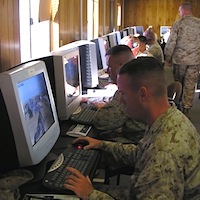 | |
Evaluation of the Training Effectiveness of Virtual Simulations in Support of
Collective Training Standards": Platoon Level Training for Convoy Operations
- web: /
- description: The goal of this study is to evaluate the initial effectiveness of the
use of a virtual training system in support of Collective Training Standards in convoy
operations training situations, when training is introduced to the users/Marines for the
first time. The study will determine if the training simulation, being an added constitutive
part of entire training cycle and preparation for Mojave Viper, brings a better and/or faster
initial improvement in overall skill level for the selected skill set.
- sponsor: Office of Naval Research (ONR), VIRTE program
- partners: USMC TTECG (Twentynine Palms, CA)
- my role: PI (2005 - 2006)
|
|
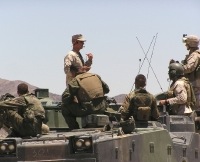 | |
Empirical Benchmark Study of Collective Performance in Combined Arms Training
- web: /
- description: Empirical study of training situation, procedures, metrics and evaluation
of overall preparedness of multiple units within Marine Corps prior to their participation in a
large scale collective training situation. The study includes qualitative and quantitative analysis
of all units performance and establishing a set of benchmarks to be used for future training.
These benchmarks can serve as a reference points when aiming for optimal training environment that
will provide best performance for several kinds of units. A special attention is given to the
role that training simulators have in enhancing units' performance in collective training
situations.
- sponsor: Office of Naval Research (ONR), VIRTE program
- partners: USMC TTECG (Twentynine Palms, CA)
- my role: PI (2004 - 2006)
|
|
 | |
Megaconference Jr.
- web: megaconferencejr.cciu.org
- description: The Student Megaconference (Megaconference Jr.) is a new project
designed to give students in elementary and secondary schools around the world the
opportunity to communicate, collaborate and contribute to each other's learning in real
time using advanced multi-point video conferencing technology.
- my role: Member of the Steering Committee, Member of the Program Committee,
consultant (2003 - 2004)
|
|
 | |
Distance Learning
- web: www.maritimeaquarium.org
- description: A study of the state of the art technological solutions and educational
projects that use videoconferencing systems in distance learning framework. The study
provided detailed recommendations for the best educational approaches and institutional policies
to be used in future programs to be offered by the Aquarium.
- my role: Co-author of the study, technology consultant (2004)
|
|
 | |
Internet Radio Project
- web: www.projectkir.org
- description: project engages youth in digital opportunities through active practice and the
act of creation. Through project web site youth can create digital audio content and present it to
their peers world-wide.
- my role: Technology and education consultant (2004-2005)
|
|
 | |
ViDe Videoconferencing Cookbook Version 4.0
- web: www.videnet.gatech.edu/cookbook
- description: one of the best and most referenced on-line resources dedicated to IP videoconferencing.
- my role: Lead and major contributor for K-12 section (new section in this version of the
cookbook; 2003 - 2004)
|
|
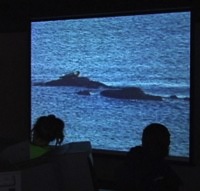 | |
Virtual Marine Biology - Seals on Camera
- web: www.wave3software.com/briarcliff.html
Top 10 Innovative Projects
http://www.techlearning.com/story/showArticle.php?articleID=16000694
- description: distance learning project that connected a group of students from Briarcliff
HS and experts from the Maritime Aquarium at Norwalk. Project explored multidisciplinary
approach and remote collaboration with scientists and staff members from the Aquarium. The
Technology and Learning magazine has selected this project as one of Top 10 innovative
projects in 2003 (listed 2nd in the article).
- my role: Project co-designer and a consultant (2002 - 2003)
|
|
 | |
Exploring the Future of Learning
|
|
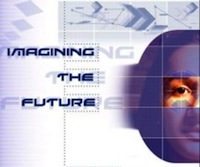 | |
Imagining the Future
|
|
 | |
Internet2: Application Quality of Service (QoS) Needs Design Team
- web: qos.internet2.edu/wq/apps ,
Internet2: www.internet2.edu
- description: the main objective of this design team was to help acquire a better understanding
of QoS needs that advanced Internet2 applications exercise. The design group was an interface
between application people and networking people, helping both to reach better common understanding
of the QoS requirements of various applications and how those requirements could be met using new
network services that are provided (or could realistically be provided) in Internet2 environment.
- my role: Chairperson (2000 - 2003)
|
|
 | |
National Tele-immersion Initiative
- web:
www.advanced.org/teleimmersion.html ,
UNC Office of the Future: www.cs.unc.edu/Research/stc/
- description: research consortium sponsored by Advanced Network and Services ($10 million investment)
and NSF, formed in collaboration with several US universities. An Internet2
application developed through the work of this research
initiative enabled users at geographically distributed sites to collaborate in real time in a shared,
simulated environment as if they are in the same physical room. This new paradigm of human-computer
interaction represents the ultimate synthesis of broadband networking and media technologies.
- partners: Brown University, University of North Carolina at Chapel Hill, University of
Pennsylvania, Philadelphia, with past participation of the Naval Postgraduate School (NSP)
- my role: Researcher and a technical coordinator of multiple university research teams and the central
NTII laboratory (1999 - 2000)
- featured journal article: Jaron Lanier (2001). Virtually There, Scientific American, April 2001
pdf
- related conference paper: Sadagic, A. Towles, H., Holden, L., Daniilidis, K., and Zeleznik, B. (2001). Tele-immersion Portal:
Towards an Ultimate Synthesis of Computer Graphics and Computer Vision Systems, 4th Annual International Workshop on Presence, Philadelphia, USA, May 2001.
document: pdf
- related conference paper: Towles, H., Chen, W.-C., Yang, R., Kum, S.-U., Fuchs, H., Kelshikar, N., Mulligan, J.,
Daniilidis, K., Holden, L., Zeleznik, B., Sadagic, A., and Lanier, J. (2002). 3D Tele-Immersion Over
Internet2, International Workshop on Immersive Telepresence (ITP2002), Juan Les Pins, France, December 2002.
document: pdf,
ppt
|
|
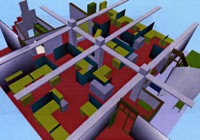 | |
Efficient Image Display for Head-Slaved Viewing of Virtual Environments
- description: PhD Thesis, defended in Mar 1999, Computer Science Department, University College London, United Kingdom.
- thesis advisor: Professor Mel Slater
- abstract (a short version): The efficient resolution of visibility in polygonal scenes was and still is one of the most demanding tasks in computer graphics. A need for faster algorithms is becoming even more important to fulfill the requirements of real-time Virtual Reality (VR) systems, and in particular immersive VR systems. The thesis investigates the construction of visibility algorithm that makes use of the resulting viewpoint movement coherence, where visibility information computed with the respect to one viewpoint may be incrementally adjusted for a subsequent viewpoint without the necessity for a full visibility computation for each frame. A special Viewpoint Movement Space (VpMS) data structure and algorithm have been designed, and results of multiple scenes rendering have been elaborated. The experimental results showed improvement in the frame rate when compared to the use of BSP trees. Methods for utilizing the same data structure for collision detection and image based rendering are discussed as well.
|
|
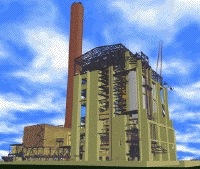 | |
The Walkthrough Project
- web: www.cs.unc.edu/~walk/
- description: Research into creating interactive computer graphics systems that enable
a viewer to experience an architectural model by simulating a walk through of the model.
- my role: Visiting Researcher - 3 months Summer 1997 internship hosted by Dr. Fred Brooks,
Department of Computer Science, University of North Carolina at Chapel Hill (UNC), NC.
|
|
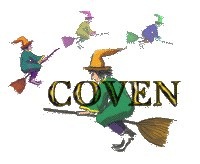 | |
COVEN
- web:
www.crg.cs.nott.ac.uk/research/projects/Coven/
System: DIVE: Distributed Interactive Virtual Environment
- description: EC ACTS funded project focused on the development of a computational service for
teleworking and virtual presence. The overall objective of the project is to provide the facilities needed
to support future cooperative teleworking systems. The project is a unique endeavour that brings together
expertise on communications infrastructures; computer supported cooperative work; virtual reality (VR) and
animation to provide support for a European wide distributed virtual environment (VE).
Partners in the project included: Division Ltd., EPFL - Swiss Federal Institute of Technology,
Integrated Information Systems Ltd, KPN Research, Lancaster University, Swedish Institute of Computer Science,
Thomson-CSF: Laboratoire Central de Recherches, TNO Physics and Electronics, University College London,
University of Geneva: Mira Lab and University of Nottingham.
- my role: Researcher (1996 - 1998)
|
|
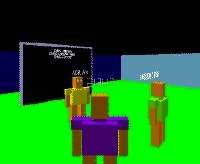 | |
Inhabiting the Web - Inhabit
|
|
| | |
PROGRAPH II
- web: Energoinvest Co.: www.energoinvest.com
PHIGS Standard:
www.itl.nist.gov/iaui/vu/cugini/pvt/hy-std.html
PHIGS (Wikipedia):
http://en.wikipedia.org/wiki/PHIGS
- description: Research program founded by the Bosnian Ministry of Science and Culture,
and Energoinvest Company (Institute for Automatics and Computer Science (IRCA)). The goal of the
program was to design and build a new graphics workstation, with appropriate suite of graphics
applications. PHIGS (ISO standard: ISO/IEC 9592 and ISO/IEC 9593) was one component of that
environment
- my role: Senior Researcher and a team leader responsible for the implementation of PHIGS
(The Programmer's Hierarchical Interactive Graphics System) graphics standard for PROGRAPH II
graphics workstation, including a low level graphics library and drivers (1987 - 1992)
|
|
